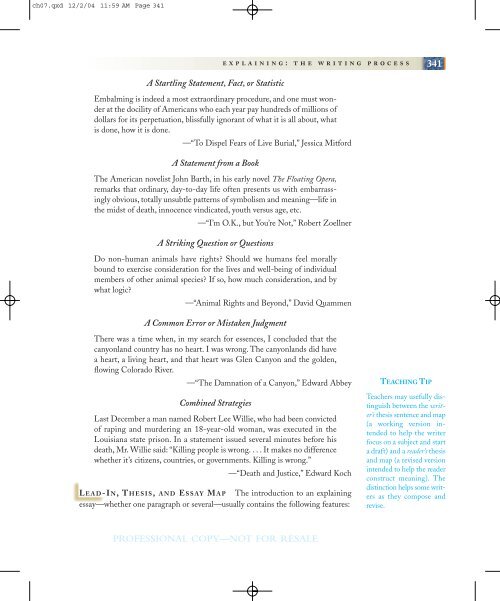A prolific painter of portraits before and after the French Revolution ...
A prolific painter of portraits before and after the French Revolution ...
A prolific painter of portraits before and after the French Revolution ...
Create successful ePaper yourself
Turn your PDF publications into a flip-book with our unique Google optimized e-Paper software.
ch07.qxd 12/2/04 11:59 AM Page 341<br />
explaining:<br />
A Startling Statement, Fact, or Statistic<br />
<strong>the</strong> writing process<br />
341<br />
Embalming is indeed a most extraordinary procedure, <strong>and</strong> one must wonder<br />
at <strong>the</strong> docility <strong>of</strong> Americans who each year pay hundreds <strong>of</strong> millions <strong>of</strong><br />
dollars for its perpetuation, blissfully ignorant <strong>of</strong> what it is all about, what<br />
is done, how it is done.<br />
—“To Dispel Fears <strong>of</strong> Live Burial,” Jessica Mitford<br />
A Statement from a Book<br />
The American novelist John Barth, in his early novel The Floating Opera,<br />
remarks that ordinary, day-to-day life <strong>of</strong>ten presents us with embarrassingly<br />
obvious, totally unsubtle patterns <strong>of</strong> symbolism <strong>and</strong> meaning—life in<br />
<strong>the</strong> midst <strong>of</strong> death, innocence vindicated, youth versus age, etc.<br />
—“I’m O.K., but You’re Not,” Robert Zoellner<br />
A Striking Question or Questions<br />
Do non-human animals have rights? Should we humans feel morally<br />
bound to exercise consideration for <strong>the</strong> lives <strong>and</strong> well-being <strong>of</strong> individual<br />
members <strong>of</strong> o<strong>the</strong>r animal species? If so, how much consideration, <strong>and</strong> by<br />
what logic?<br />
—“Animal Rights <strong>and</strong> Beyond,” David Quammen<br />
A Common Error or Mistaken Judgment<br />
There was a time when, in my search for essences, I concluded that <strong>the</strong><br />
canyonl<strong>and</strong> country has no heart. I was wrong. The canyonl<strong>and</strong>s did have<br />
a heart, a living heart, <strong>and</strong> that heart was Glen Canyon <strong>and</strong> <strong>the</strong> golden,<br />
flowing Colorado River.<br />
—“The Damnation <strong>of</strong> a Canyon,” Edward Abbey<br />
Combined Strategies<br />
Last December a man named Robert Lee Willie, who had been convicted<br />
<strong>of</strong> raping <strong>and</strong> murdering an 18-year-old woman, was executed in <strong>the</strong><br />
Louisiana state prison. In a statement issued several minutes <strong>before</strong> his<br />
death, Mr. Willie said: “Killing people is wrong....It makes no difference<br />
whe<strong>the</strong>r it’s citizens, countries, or governments. Killing is wrong.”<br />
—“Death <strong>and</strong> Justice,” Edward Koch<br />
L EAD-IN ,THESIS, AND E SSAY M AP The introduction to an explaining<br />
essay—whe<strong>the</strong>r one paragraph or several—usually contains <strong>the</strong> following features:<br />
TEACHING TIP<br />
Teachers may usefully distinguish<br />
between <strong>the</strong> writer’s<br />
<strong>the</strong>sis sentence <strong>and</strong> map<br />
(a working version intended<br />
to help <strong>the</strong> writer<br />
focus on a subject <strong>and</strong> start<br />
a draft) <strong>and</strong> a reader’s <strong>the</strong>sis<br />
<strong>and</strong> map (a revised version<br />
intended to help <strong>the</strong> reader<br />
construct meaning). The<br />
distinction helps some writers<br />
as <strong>the</strong>y compose <strong>and</strong><br />
revise.<br />
PROFESSIONAL COPY—NOT FOR RESALE

















